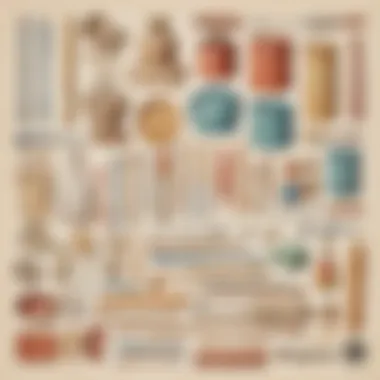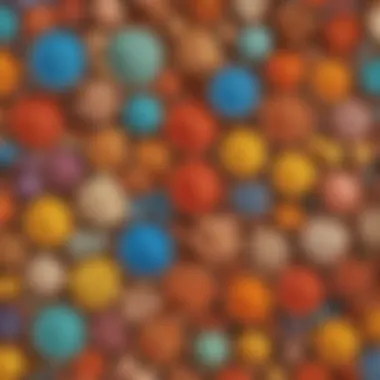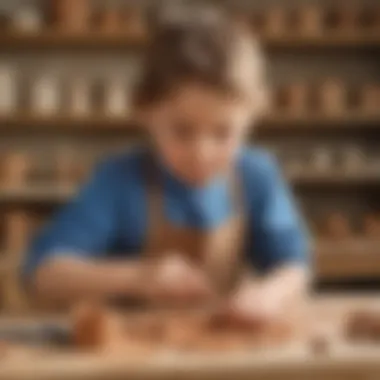Crafting the Perfect Clay Recipe: A Comprehensive Guide for Young Scientists


Science Fun Facts
Clay has been used for thousands of years for various purposes, including pottery, sculptures, and even as part of ancient healing rituals. The earliest known clay objects date back to around 29,000 BC, showcasing the enduring nature of this versatile material.
Discover the Wonders of Science
Delving into the world of clay involves understanding its properties and composition. Clay is a type of fine-grained natural soil material comprised of minerals like kaolinite, montmorillonite, and illite. These minerals give clay its malleable and adhesive qualities, making it ideal for shaping and molding.
Science Quiz Time
Test your knowledge of clay with these fun quiz questions:
- What is the primary composition of clay? A. Silica B. Iron Oxide C. Alumina D. All of the above
Science Experiment Showcase
Embark on a clay-making journey through exciting experiments:
- Experiment 1: Creating Clay from Scratch Materials Needed: Water, soil samples, sieves, containers Instructions: Collect soil samples, sieve to remove debris, combine with water to form a pliable clay mix. Remember to wear gloves for safety.
Introduction
In this digital era, where screens dominate the landscape, nurturing the scientific curiosity of young minds is paramount. The intricate art of crafting clay serves as a gateway to a world where knowledge intertwines with creativity, offering a tactile experience that transcends traditional learning methods. Through this comprehensive guide, young science enthusiasts aged 6-12 are provided with a profound opportunity to immerse themselves in the wonders of clay creation. By delving into the properties, significance, and educational benefits of clay, this article endeavors to ignite a spark of innovation and experimentation in our budding scientists.
Understanding Clay


Properties of Clay
Clay, a malleable earth material, boasts a plethora of distinctive properties that render it indispensable in the realm of scientific exploration. Its pliable nature allows for seamless sculpting, encouraging hands-on engagement essential for cognitive development. The cohesiveness of clay enables young minds to refine their motor skills, promoting dexterity and precision in their creations. Furthermore, the innate ability of clay to retain moisture ensures prolonged usability, paving the way for sustained artistic endeavors. Despite its commendable qualities, clay's propensity to air dry swiftly mandates expedited sculpting, challenging enthusiasts to work swiftly and decisively. This duality of clay, balancing flexibility with a sense of urgency, amplifies its allure as a versatile medium for scientific expression.
Importance of Clay in Science Education
Enhancing Creativity
At the core of clay's significance in science education lies its unparalleled capacity to stimulate creativity. By molding amorphous clay into tangible forms, young learners harness their imaginative faculties, giving shape to abstract ideas and envisioning innovative possibilities. This creative process transcends conventional artistic pursuits, fostering critical thinking and problem-solving skills essential for scientific inquiry. Through the medium of clay, budding scientists tangibly interact with theoretical concepts, bridging the gap between theory and practice in a visually captivating manner.
Hands-On Learning
Hands-on learning, facilitated by clay manipulation, offers a dynamic approach to scientific education, entwining theory with experiential discovery. Tactile engagement with clay empowers young enthusiasts to internalize scientific principles through kinesthetic channels, facilitating a comprehensive understanding of complex concepts. The tactile sensation of clay beneath their fingers immerses children in a sensorial learning experience, enhancing retention and comprehension. Moreover, the trial-and-error inherent in clay sculpting nurtures resilience and adaptability, instilling valuable lessons in experimentation and iterative improvement.
Materials Required
Crafting the perfect clay recipe requires specific materials to ensure the quality and success of the final product. These materials play a crucial role in the clay-making process, providing the necessary components for creating a malleable and versatile clay mixture. Understanding the importance of each ingredient is essential for young science enthusiasts embarking on this creative journey.
List of Ingredients
Flour
Flour is a fundamental ingredient in clay-making, serving as the base material that provides structure and consistency to the mixture. Its fine texture allows for smooth manipulation of the clay, enabling young creators to shape and mold their creations with ease. The key characteristic of flour lies in its ability to bind the other ingredients together, resulting in a cohesive clay compound. This popular choice for clay recipes offers a cost-effective and easily accessible option for aspiring scientists. The unique feature of flour is its versatility, making it adaptable to various clay projects. However, it is important to note that the flour-to-water ratio must be carefully balanced to achieve the desired clay consistency.
Salt
Salt acts as a significant component in clay recipes, contributing to the texture and durability of the final product. Its presence helps prevent the clay from becoming too sticky while adding stability to the mixture. The key characteristic of salt lies in its ability to absorb excess moisture, maintaining the clay's form and shape during the drying process. This popular choice for clay recipes offers a natural and affordable option for creating long-lasting clay sculptures. The unique feature of salt is its preservative properties, extending the lifespan of clay creations. However, excessive salt can lead to brittleness in the clay, requiring careful measurement and mixing to avoid potential disadvantages.


Water
Water plays a vital role in clay-making, serving as the primary liquid component that activates the other ingredients. Its presence helps bind the flour and salt together, forming a pliable clay mixture suitable for sculpting. The key characteristic of water is its ability to hydrate the dry ingredients, facilitating the blending process and ensuring a cohesive clay texture. This essential element is a popular choice for clay recipes due to its accessibility and simplicity in preparation. The unique feature of water is its transformative quality, turning a dry mixture into a workable clay medium. However, controlling the water amount is crucial to prevent the clay from becoming too wet or sticky, requiring careful monitoring and adjustment throughout the mixing process.
Optional: Food Coloring
Food coloring offers a fun and creative addition to clay-making, allowing young scientists to personalize their creations with vibrant hues. Its contribution to the overall clay recipe lies in enhancing the visual appeal and artistic expression of the final product. The key characteristic of food coloring is its ability to tint the clay mixture, providing endless possibilities for color combinations and designs. This optional ingredient is a popular choice for adding a playful touch to clay projects, stimulating imagination and creativity in young artists. The unique feature of food coloring is its versatility, enabling precise color customization and artistic experimentation. However, moderate use of food coloring is advised to prevent staining and ensure safe handling, encouraging responsible and mindful usage in clay crafting activities.
Step-by-Step Guide
Crafting the perfect clay recipe is a meticulous process that guarantees an engaging and educational experience for young science enthusiasts. This section will break down the essential steps involved in creating the ideal clay mixture, fostering creativity and scientific exploration. By following these detailed instructions, children aged 6-12 can embark on a hands-on journey to sculpting their imaginations into tangible forms, promoting cognitive development and artistic expression.
Preparing the Mixture
Mixing Flour and Salt
Mixing flour and salt is a foundational step in clay preparation, serving as the base that determines the texture and pliability of the final product. This essential combination sets the groundwork for shaping the clay into various forms, stimulating sensory play and encouraging fine motor skills development. The utilization of flour and salt as primary ingredients offers a cost-effective and easily accessible solution for creating sculpting materials, aligning with the educational and economic aspects of this article. While this mixture provides a malleable consistency ideal for crafting, it may require adult supervision due to the use of raw ingredients and potential allergic reactions in sensitive individuals.
Gradually Adding Water
The gradual incorporation of water into the flour and salt mixture is a critical step that influences the cohesiveness and workability of the clay. By slowly introducing water, young scientists can adjust the consistency to achieve the desired level of moldability, enhancing their tactile experience and problem-solving skills. This incremental approach empowers children to explore the varying effects of hydration on the clay's elasticity and structural integrity, promoting sensory awareness and scientific inquiry. Although this method encourages experimentation and creativity, excessive water may lead to a sticky or soft texture that compromises the clay's durability, emphasizing the importance of moderation and precision throughout the mixing process.
Adding Color (If Desired)
Incorporating Food Coloring
The option to add color to the clay introduces an artistic element that sparks imaginative expression and aesthetic exploration. Incorporating food coloring not only enhances the visual appeal of the sculptures but also offers a creative outlet for customizing designs and engaging in color theory experiments. This supplementary step enables young learners to personalize their creations, reinforcing self-expression and aesthetic appreciation. While food coloring expands the creative possibilities of the clay, it is essential to exercise caution to prevent stains on surfaces and skin, emphasizing the importance of responsible and supervised artistry in this hands-on activity.


Tips for Perfecting Your Clay
Crafting the perfect clay is an art that requires attention to detail. In this section, we delve into the essential tips to ensure your clay turns out just right. Consistency matters significantly when it comes to creating a high-quality clay mixture that is both malleable and durable. By following these tips, young science enthusiasts can elevate their clay crafting experience and enhance their scientific exploration journey.
Consistency plays a pivotal role in the overall quality of the clay. Achieving the right texture is crucial for molding and shaping the clay effectively. The consistency of the mixture impacts how well it holds together, allowing young minds to experiment and create various structures with ease. The ideal texture strikes a balance between being soft enough to mold effortlessly yet firm enough to maintain shapes once formed.
Perfecting the texture of the clay opens up a world of possibilities for budding scientists. It encourages experimentation and fosters creativity as children discover the tactile nature of clay manipulation. Moreover, the right consistency ensures that the clay remains pliable for an extended period, offering ample time for sculpting intricate designs and exploring scientific concepts through hands-on engagement.
Embracing the principles of achieving the right texture equips young learners with the skills to express their imaginative ideas through clay modeling. This fundamental aspect not only refines motor skills but also enhances cognitive development as children engage in sensory-rich play experiences. As they knead, shape, and mold the clay to their liking, they develop a deeper understanding of form, structure, and scientific concepts embedded in their creations.
Educational Benefits
In this article, delving into the educational benefits of crafting clay unveils a world of hands-on learning experiences for young science enthusiasts aged 6-12. By engaging in the process of making clay, children are not only having fun but also sharpening their cognitive skills. The act of mixing flour, salt, and water to create clay enhances problem-solving abilities, as young minds experiment with different proportions to achieve the desired consistency. Besides, crafting clay promotes sensory exploration as children engage their sense of touch and smell, fostering heightened sensory awareness. This sensory engagement contributes to the development of fine motor skills as kids manipulate the clay, knead it, and mold it into various shapes, thereby promoting dexterity and coordination. Furthermore, exploring and creating with clay encourages creativity and imagination, providing a platform for self-expression and innovation as children design unique sculptures and structures, expanding their artistic horizons.
Learning Through Play
Enhancing Motor Skills
The aspect of enhancing motor skills through clay crafting is a cornerstone of this article's focus. By engaging in hands-on activities like shaping and molding clay, children are immersed in tactile experiences that refine their fine motor skills. The intricate movements required to roll, pinch, and flatten clay aid in strengthening hand muscles and improving hand-eye coordination. This process of manipulating clay helps children enhance their finger dexterity, essential for activities such as writing and drawing. Additionally, the sensory input received while working with clay stimulates nerve endings, contributing to sensory integration and the refinement of motor skills. One of the notable advantages of enhancing motor skills through clay play is the opportunity for children to develop precision and control in their movements, laying a foundation for various practical skills.
Fostering Creativity
The promotion of creativity in young minds through clay crafting takes center stage in this article's exploration. Clay serves as a versatile medium that encourages open-ended play, allowing children to explore their artistic inclinations freely. The act of sculpting with clay fosters divergent thinking as children conceptualize and bring their ideas to life through three-dimensional creations. This freedom to experiment with textures, shapes, and colors nurtures innovative thinking and problem-solving abilities as young artists navigate the complexities of their artistic vision. Moreover, clay crafting offers a sensory-rich experience that inspires self-expression, enabling children to communicate feelings and ideas through their clay creations. By fostering creativity, clay play sparks a sense of curiosity and exploration, empowering children to think outside the box and embrace their unique artistic identities.
Conclusion
Crafting the Perfect Clay Recipe is not just about mixing ingredients; it's a gateway to a world of creativity and learning for young minds. By engaging in this hands-on activity, children aged 6-12 can delve into the realm of science while honing their motor skills and fostering artistic expression. This guide goes beyond the mere creation of clay; it instills a sense of curiosity and exploration that is essential for intellectual development.
Encouraging Exploration
Embracing Scientific Curiosity
In the grand scheme of educational endeavors, embracing scientific curiosity stands out as a beacon for young learners. This aspect emphasizes questioning, experimentation, and the innate desire to understand the workings of the world. By encouraging children to ask







